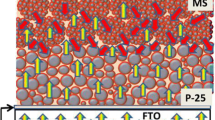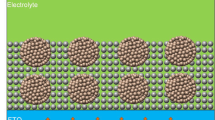Abstract
Different structures of TiO2 photoelectrodes were fabricated with various arrangement modes of the layers. TiO2 nanoparticles were synthesized by a combination of sol–gel and solvothermal methods and were employed as the active layer of solar cells. Hierarchical TiO2 spheres (HTS) and spherical TiO2 particles (STP) were also prepared by hydrothermal and sol–gel processes, respectively, and used as the scattering layer of solar cells. Field emission scanning electron microscope and X-ray diffraction analyses revealed that all synthesized morphologies showed anatase structure with particle size around 20, 200–400 nm and 1.5–2.0 µm for the nanoparticles, spherical particles and hierarchical spheres, respectively. Moreover, the nanoparticles, spherical particles and hierarchical spheres had surface areas of 131.1, 5.7 and 253.5 m2/g, respectively. The optical properties of these morphologies were studied through diffuse reflectance spectroscopy analysis. The indirect optical band gap energy of the nanoparticles, spherical particles and hierarchical spheres was calculated 3.10, 3.14 and 3.13 eV, respectively. Furthermore, the light scattering particles (i.e., HTS and STP) exhibited high diffuse reflectance because of their large particle size. The improvement of power conversion efficiency of monolayer cells was achieved by light harvesting mechanism aided by controlling the thickness of the film. The monolayer solar cell made of TiO2 nanoparticles with 20 μm thickness showed the highest efficiency of 7.21 %. Further enhancement of photovoltaic performance was obtained by light scattering mechanism aided by fabrication of double-layer solar cells with different arrangement modes of the layers. The enhancement was attributed to higher incident photon-to-current conversion yield due to greater fraction of light scattering as well as less recombination of photogenerated electrons. Hierarchical spheres had the highest amount of dye adsorption, whereas spherical particles showed the greatest light scattering property. In addition, incorporation of nanoparticles into hierarchical spheres and spherical particles would lead to better connection between the particles and retard charge recombination in the photoanode. It was found that the influence of electron transport rate on cell efficiency improvement is more dominant than that of light scattering. Therefore, the double-layer solar cell made of TiO2 nanoparticles as the active layer and mixtures of nanoparticles and hierarchical particles as the scattering layer showed the highest efficiency of 8.21 % among all fabricated solar cells.
Graphical Abstract
Different structures of TiO2 photoelectrodes were fabricated with various arrangement modes of the layers containing TiO2 nanoparticles, hierarchical TiO2 spheres and spherical TiO2 particles for dye-sensitized solar cell applications.











Similar content being viewed by others
References
O′Regan B, Grätzel M (1991) A low-cost, high-efficiency solar-cell based on dye-sensitized colloidal TiO2 films. Nature 353:737–740
Hagfeldt A, Boschloo G, Sun L, Kloo L, Pettersson H (2010) Dye-sensitized solar cells. Chem Rev 110:6595–6663
Ito S, Murakami TN, Comte P, Liska P, Grätzel M, Nazeeruddin MK (2008) Fabrication of thin film dye sensitized solar cells with solar to electric power conversion efficiency over 10 %. Thin Solid Films 516:4613–4619
Ambrus Z, Mogyorósi K, Ambrus Z, Szalai A, Alapi T, Demeter K, Dombi A, Sipos P (2008) Low temperature synthesis, characterization and substrate-dependent photocatalytic activity of nanocrystalline TiO2 with tailor-made rutile to anatase ratio. Appl Catal A 340:153–161
Clifford JN, Palomares E, Nazeeruddin MK, Thampi R, Grätzel M, Durrant JR (2004) Multistep electron transfer processes on dye co-sensitized nanocrystalline TiO2 films. Chem Soc 126:5670–5671
Rao CN, Deepak FL, Gundiah G, Govindaraj A (2003) Inorganic nanowires. Solid State Chem 31:5–147
Zhu K, Kopidakis N, Neale NR, van de Lagemaat J, Frank AJ (2006) Influence of surface area on charge transport and recombination in dye-sensitized TiO2 solar cells. J Phys Chem B 110:25174–25180
Zhang Q, Cao G (2011) Nanostructured photoelectrodes for dye-sensitized solar cells. Nano Today 6:91–109
Nakade S, Saito Y, Kubo W, Kitamura T, Wada Y, Yanagida S (2003) Influence of TiO2 nanoparticle size on electron diffusion and recombination in dye-sensitized TiO2 solar cells. J Phys Chem B 107:8607–8611
Usami A (1997) Theoretical study of application of multiple scattering of light to a dye-sensitized nanocrystalline photoelectrichemical cell. Chem Phys Lett 277:105–108
Hore S, Vetter C, Kern R, Smit H, Hinsch A (2006) Influence of scattering layers on efficiency of dye-sensitized solar cells. Sol Energy Mater Sol Cells 90:1176–1188
Zhang Q, Cao G (2001) Hierarchically structured photoelectrodes for dye-sensitized solar cells. J Mater Chem 21:6769–6774
Lin YP, Lin SY, Lee YC, Chen-Yang TW (2013) High surface area electron prickle-like hierarchical anatase TiO2 nanofibers for dye-sensitized solar cell photoanodes. J Mater Chem A 1:9875–9884
Wu YC, Tai YC (2013) Effects of alcohol solvents on anatase TiO2 nanocrystals prepared by microwave-assisted solvothermal method. J Nanoparticle Res 15:1686–1696
Jiang XC, Herricks T, Xia YN (2003) Monodispersed spherical colloids of titania synthesis, characterization, and crystallization. Adv Mater 15:1205–1208
Zheng Z, Huang B, Qin X, Zhang X, Dai Y (2010) Strategic synthesis of hierarchical TiO2 microspheres with enhanced photocatalytic activity. Chem Eur J 16:11266–11270
Mohammadi MR, Louca RRM, Fray DJ, Welland ME (2012) Dye-sensitized solar cells based on a single layer deposition of TiO2 from a new formulation paste and their photovoltaic performance. Sol Energy 86:2654–2664
Ito S, Liska P, Pechy P, Bach U, Nazeeruddin MK, Kay A, Zekeeruddin SM, Grätzel M (2005) Control of dark current in photoelectrochemical (TiO2/I−–I3 −) and dye-sensitized solar cells. Chem Commun 34:4351–4353
Nazeeruddin MK, Kay A, Rodicio I, Humphry-Baker R, Muller E, Liska P, Vlachopoulos N, Grätzel M (1993) Conversion of light to electricity by cis-X2bis (2,2′-bipyridyl-4,4′-dicarboxylate) ruthenium(II) charge-transfer sensitizers on nanocrystalline titanium dioxide electrodes. J Am Chem Soc 115:6382–6390
Cullity BD (1977) Elements of X-ray diffraction, 2nd edn. Addison-Wesley, San Diego
Sing KSW, Everet DH, Haul RAW, Moscou L, Pierotti RA, Rouquerol J, Siemieniewska T (1985) Reporting physisorption data for gas/solid systems with special reference to the determination of surface area and porosity. Pure Appl Chem 57:603–619
Yang L, Lin Y, Jia J, Xiao X, Li X, Zhou X (2008) Light harvesting enhancement for dye-sensitized solar cells by novel anode containing cauliflower-like TiO2 spheres. J Power Sources 182:370–376
Tauc J (1974) Amorphous and liquid semiconductors. Plenum Press, London
Lin H, Huang CP, Li W, Ni C, Ismat Shah S, Tseng YH (2006) Size dependency of nanocrystalline TiO2 on its optical property and photocatalytic reactivity exemplified by 2-chlorophenol. Appl Catal B Environ 68:1–11
Dittrich T (2000) Porous TiO2: electron transport and application to dye sensitized injection solar cells. Stat Sol 182:447–455
Diamant Y, Chen SG, Melamed O, Zaban A (2003) Core-shell nanoporous electrode for dye sensitized solar cells: the effect of the SrTiO3 shell on the electronic properties of the TiO2 core. J Phys Chem B 107:1977–1981
Feigenbrugel V, Loew C, Calvé SL, Mirabel P (2005) Near-UV molar absorptivities of acetone, alachlor, metolachlor, diazinon and dichlorvos in aqueous solution. J Photochem Photobiol A Chem 174:76–81
Fotsa Ngaffo F, Caricato AP, Fernandez M, Martino M, Romano F (2007) Structural properties of single and multilayer ITO and TiO2 films deposited by reactive pulsed laser ablation deposition technique. Appl Surf Sci 253:6508–6511
Park NG, Vande Lagemaat J, Frank AJ (2000) Comparison of dye-sensitized rutile- and anatase-based TiO2 solar cells. J Phys Chem B 104:8989–8994
Barbe CJ, Arendse F, Comte P, Jirousek M, Lenzmann F, Shklover V, Grätzel M (1997) Nanocrystalline titanium oxide electrodes for photovoltaic applications. J Am Ceram Soc 80:3157–3171
Acknowledgments
M. R. Mohammadi wishes to thank the financial support from Iran National Science Foundation (INSF).
Author information
Authors and Affiliations
Corresponding author
Rights and permissions
About this article
Cite this article
Garmaroudi, Z.A., Mohammadi, M.R. Design of TiO2 dye-sensitized solar cell photoanode electrodes with different microstructures and arrangement modes of the layers. J Sol-Gel Sci Technol 76, 666–678 (2015). https://doi.org/10.1007/s10971-015-3819-9
Received:
Accepted:
Published:
Issue Date:
DOI: https://doi.org/10.1007/s10971-015-3819-9




